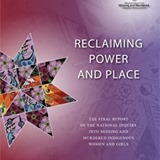 Part Two of the MMIWG report focuses on Confronting Oppression. Chapter 5, the first of four in this section, looks at Right to Culture.
Part Two of the MMIWG report focuses on Confronting Oppression. Chapter 5, the first of four in this section, looks at Right to Culture.
Culture is defined as the sum total of material and spiritual activities which distinguish a given social group, including their ways of life, language, history, literature, belief systems, ceremonies, environments, and traditions. Colonization, through concerted efforts at assimilation, altered the relationships of Indigenous people to their culture and identity.
Patterns of cultural violence included seizure of traditional lands, expropriation of Indigenous cultural objects, misinterpretation of their history, suppression of their language and ceremonies, forced removal of children from families, and a process of dehumanization through education.
The Report concludes Canada’s child welfare system has failed to meet core principles regarding the rights of children. For example, child welfare laws were used as tools of genocide, apprehension is seen as a form of violence, children in care were not protected from abuse and exploitation and were not supported to grow safely into adulthood, removal of children because of poverty was a form of discrimination especially when more funding was provided for apprehension than for families. In fact, a direct link was found between current child welfare systems and the numbers of MMIWG.
Many systems were catalysts for violence against Indigenous women and girls and resulted in their physical and emotional abuse. Subsequent struggles with poverty, homelessness, addictions, and other challenges were compounded by lack of access to familial, community, and cultural support. Sources of stress include racism, poverty, poor education, unemployment, family instability, and residential instability. Poverty was used to justify apprehension of children.
Additional insult was added by historical media representations where Indigenous women were primarily framed as sex workers and criminals. Even the current euphemism of “high risk” implies personal responsibility for lifestyle.
The Path Forward is to recognize the Truth that MMIWG have spirit and are valued members of their community. Indigenous people are experts of their own lives and must tell their own stories on their own terms for truthful and fair media representation.
Cultural principles provide the foundation for creating empowering spaces for women. “When we talk about our women, we talk about our land. When we talk about our land, we talk about our spirits. We talk about our traditions, our people, our Elders, our children.” (p.402) One cannot exercise civil and political right without economic, social and cultural rights. Canada is called to condemn and eliminate racial discrimination in keeping with international human rights.
In summary, ten findings include:
- “Assimilation” led directly to high rates of violence against Indigenous women.
- Indigenous women were denied the right to be part of their own culture.
- Inter-generational cultural knowledge has been broken by cultural genocide.
- The Indian Act perpetuated racial and gendered violence.
- Government role in determining cultural belonging infringed on inherent rights.
- The Indian Act was discriminatory to women and their descendants.
- Policies that denied Indigenous identity resulted in exclusion from community.
- The Indian Act denied First Nations women their traditional leadership roles.
- Restoration of family and community is key to revitalization of culture and safety.
- Indigenous children and youth have the right to be educated in their language and culture.
Personal Reflection: While reviewing this chapter, I pondered my ambivalence about my own cultural traditions. Both my parents came from families who immigrated from Europe, so there were traits of adventure and resourcefulness on both sides. However, one family seemed to be more gentle and cultured, while the other was tainted with abuse and addiction. The second was a tradition I rejected and strove to be different from. It is too simplistic to assume that all family values are rooted in exemplary behavior. When the shadow of trauma manifests, it is difficult to find traditions worth celebrating and instead we seek signs of resilience and courage and hope. Those who have little conscious memory of positive cultural values face the challenge of creating a new identity for themselves.

